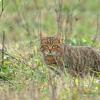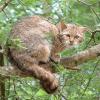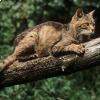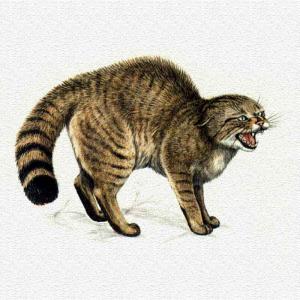Il Gatto selvatico (Felis silvestris, Schreber, 1775) è un mammifero carnivoro della famiglia dei Felidi
L'areale della specie nel suo insieme è assai vasto, anche se attualmente frammentato nelle zone più antropizzate:In Italia la sottospecie nominale è presente in tutta l'area interna del centro-meridionale. In Provincia di Salerno si trova nei Parchi, oasi naturali, dove la presenza dell'uomo è limitata.
Il gatto selvatico europeo è un abitatore delle foreste di latifoglie ad altezze medio-basse (in una fascia compresa tra 300/400 e 800 m), mentre evita le zone montane con copertura nevosa.
Ha abitudini notturne: durante il giorno sonnecchia nel folto della vegetazione o in rifugi veri e propri. Si tratta di animali territoriali, che delimitano un proprio territorio piuttosto vasto (in media 10 km²) marcandolo con segnali odorosi e visivi (ad esempio segnando i tronchi con le proprie unghie) e pattugliandolo costantemente per scoprire eventuali intrusi. Le aree periferiche del territorio possono sovrapporsi a quelle di altri esemplari, senza che ciò comporti scontri violenti.
Il suo aspetto ricorda quello di un gatto soriano ma ha la testa più grande e il pelo più scuro. I maschi si differenziano dalle femmine per la taglia, decisamente superiore (5,500-3,550 kg), anche se vi possono essere delle variazioni a seconda delle stagioni.
Caccia prevalentemente piccoli roditori, uccelli e rettili, ma quando il cibo scarseggia non disdegna di mangiare anche insetti. Ottimo pescatore, generalmente riesce a catturare piccoli pesci artigliandoli, dopo un paziente lavoro di attese e appostamenti.
Solitario e territoriale, il gatto selvatico non forma coppie stabili: si accoppia in primavera, la gestazione dura 9-10 settimane e la femmina dà alla luce tra i 2 e i 4 piccoli (le gravidanze singole sono rarissime); la madre resta con i piccoli solo fino al raggiungimento dell'autosufficienza, generalmente all'età di 3-4 mesi. La loro speranza di vita in natura si aggira attorno ai 15 anni.
La specie di gatto selvatico è inserita dall'IUCN nella categoria di minaccia LC-Least Concern (a rischio minimo).
Tra i fattori di minaccia vi sono quelli comuni a tutte le popolazioni selvatiche come la modificazione e la frammentazione degli habitat e il bracconaggio, cui se ne aggiunge, in questo caso, una più specifica e, per così dire peculiare a questa specie : l'ibridazione con il gatto domestico.

The wildcat is a carnivorous mammal of the Felidae family. The range of the species as a whole is very broad, although currently fragmented in the most populated areas: In Italy the nominal subspecies is found throughout the interior area of the southern-centre. In the province of Salerno it can be found in parks, nature reserves, where human presence is limited.
The European wildcat is an inhabitant of hardwood forests at medium-low heights (including in a range between 300/400 to 800 m), while avoiding the mountainous areas with snow cover.
The wildcats have nocturnal habits, as during the day they doze in the thick vegetation or in shelters. They are territorial animals that delimit their own rather large territory (on average of 10 km²), marking it with fragrant and visual signals (for example by scoring the trunks with their nails), and patrolling constantly to detect any intruders. Peripheral areas of the territory may overlap with those of other specimens, without involving violent clashes.
Their appearance resembles that of tabby cats but they have the largest heads and darker hair. Males differ from females by size, 5.5 to 3.5 kg, although there may be variations depending on the seasons.
Wildcats mainly hunt small rodents, birds and reptiles, but when food is scarce they are not reluctant to eat insects. Also, they are excellent fishers, with the ability to catch small fish, after a long time waiting and stalking.
Wildcats do not form stable pairs, as they mate in the spring, with the gestation lasts from 9-10 weeks and the female gives birth to between 2 and 4 small offspring (single pregnancies are very rare). The mother remains with the offspring until they can take care of themselves, usually at the age of 3-4 months. The life expectancy in the wild is around 15 years.
The species is listed in the IUCN category of threat as LC-Least Concern. Amongst the factors of threat are those common to all the wild populations as the modification and fragmentation of habitats and poaching. In addition, in this case, the hybridisation with domestic cats.







